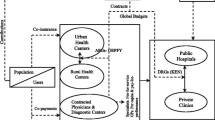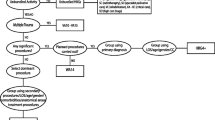Abstract
Financial incentives in primary care have been introduced with the purpose of improving appropriateness of care and containing demand. We usually observe pay-for-performance programs, but alternatives, such as pay-for-participation in improvement activities and pay-for-compliance with clinical guidelines, have also been implemented. Here, we assess the influence of different programs that ensure extra payments to GPs for containing avoidable hospitalisations. Our dataset covers patients and GPs of the Italian region Emilia-Romagna for the year 2005. By separating pay-for-performance from pay-for-participation and pay-for-compliance programs, we estimate the impact of different financial incentives on the probability of avoidable hospitalisations. As dependent variable, we consider two different sets of conditions for which timely and effective primary care should be able to limit the need for hospital admission. The first is based on 27 medical diagnostic related groups that Emilia-Romagna identifies as at risk of inappropriateness in primary care, while the second refers to the internationally recognised ambulatory care-sensitive conditions. We show that pay-for-performance schemes may have a significant effect over aggregate indicators of appropriateness, while the effectiveness of pay-for-participation schemes is adequately captured only by taking into account subpopulations affected by specific diseases. Moreover, the same scheme produces different effects on the two sets of indicators used, with performance improvements limited to the target explicitly addressed by the Italian policy maker. This evidence is consistent with the idea that a “tunnel vision” effect may occur when public authorities monitor specific sets of objectives as proxies for more general improvements in the quality of health care delivered.


Similar content being viewed by others
References
Lippi Bruni, M., Nobilio, L., Ugolini, C.: Economic incentives in general practice: the impact of pay-for-participation and pay-for-compliance programs on diabetes care. Health Policy 90, 140–148 (2009)
Billings, J., Zeitel, L., Lukomnik, J., Carey, T.S., Blank, A.E., Newman, L.: Impact of socioeconomic status on hospital use in New York City. Health Aff. 12, 162–173 (1993)
Goldstein, H.: Multilevel statistical methods, 3rd edn. Kluwer, London (2003)
Prendergast, C.: The provision of incentives in firms. J. Econ. Lit. 37, 7–63 (1999)
Laffont, J.J., Martimort, D.: The theory of incentives: the principal-agent model. Princeton University Press, Princeton (2002)
Frey, B.S., Jegen, R.: Motivation crowding out theory: a survey of empirical evidence. J. Econ. Survey 15, 589–611 (2001)
Gneezy, U., Rustichini, A.: Pay enough or don’t pay at all. Q. J. Econ. 115, 791–810 (2000)
Lazear, E.P.: Performance pay and productivity. Amer. Econ. Rev. 90, 1346–1361 (2000)
Heckman, J.J., Smith, J.A., Taber, C.: What do bureaucrats do? The effects of performance standards and bureaucratic preferences on acceptance into the JTPA program. NBER working papers 5535 (1996)
Lavy, V.: Performance pay and teachers’ effort, productivity and grading ethics, NBER working papers 10622 (2004)
Dixit, A.: Incentives and organisations in the public sector: an interpretative review. J. Human Res. 37, 696–727 (2002)
Smith, P.: On the unintended consequences of publishing performance data in the public sector. Int. J. Public Adm. 18, 277–310 (1995)
Goddard, M., Mannion, R., Smith, P.: Enhancing performance in health care: a theoretical perspective on agency and the role of information. Health Econ. 9, 95–107 (2000)
Scott, A., Schurer, S., Jensen, P.H., Sivey, P.: The effects of financial incentives on quality of care in diabetes management. Health Econ. 18, 1091–1108 (2009)
Cutler, D.M.: The economics of health system payment. Economist 154, 1–18 (2006)
Doran, T., Fullwood, C., Gravelle, H., et al.: Pay-for-performance programs in family practices in the United Kingdom. N. Engl. J. Med. 355, 375–384 (2006)
Mannion, R., Goddard, M., Bate, A.: Aligning incentives and motivations in health care: the case of earned autonomy. Finan. Acc. Manage. 23, 401–420 (2007)
Godager, G., Iversen, T., Ma, A.: Service motives and profit incentives among physicians. Int. J. Health Care Finance Econ. 9, 39–57 (2009)
Smith, P.: Measuring health system performance. Eur. J. Health Econ. 3, 145–148 (2002)
Olsen K.R., Gyrd-Hansen D., Boegh A., Hartung Hansen S.: GPs as citizens’ agents: prescription behavior and altruism. Eur. J. Health Econ. 10, 399–407 (2009)
Birkmeier, N.J., Birkmeier, J.D.: Strategies for improving surgical quality–should payers reward excellence or effort? N. Engl. J. Med. 354, 864–870 (2006)
Caminal, J., Starfield, B., Sanchez, E., Casanova, C., Morales, M.: The role of primary care in preventing ambulatory care sensitive conditions. Eur. J. Public Health 14, 246–251 (2004)
Charlson, M., Pompei, P., Ales, K., McKenzie, C.: A new method of classifying prognostic comorbidity in longitudinal studies: development and validation. J. Chronic. Dis. 40, 373–378 (1987)
Romano, P.S., Roos, L.L., Jollis, J.G.: Adapting a clinical comorbidity index for use with ICD-9-CM administrative data: differing perspectives. J. Clin. Epidemiol. 46, 1075–1079 (1993)
Iversen, T., Luras, H.: Economic motives and professional norms: the case of general medical practice. J. Econ. Behav. Organ. 43, 447–470 (2000)
Guo, G., Zhao, H.: Multilevel modelling for binary data. Annu. Rev. Sociol. 26, 441–462 (2000)
Rasbash, J., Browne, W., Goldstein, H., et al.: Guide to MLWIN, VERSION 2.1. Institute of education, London (2000)
Browne, W.J., Subramanian, S.V., Jones, K., Goldstein, H.: Variance partitioning in multilevel logistic models. J. R. Statist. Soc. Series A 168, 599–610 (2005)
Acknowledgments
This paper is part of the research projects: “The role of economic incentives in primary care”, funded by the Italian Ministry of Health; and “Demand regulation and supply incentives in the NHS”, funded by the Italian Ministry of University and Research (MIUR). Elisa Iezzi thanks “Fondazione Cassa dei Risparmi di Forlì” for the financial support. The authors thank two anonymous referees and participants at the ECHE (Rome), SIEP (Pavia) and AIES (Matera) conferences for useful suggestions, and the Regional Agency for Health and Social Care for kindly providing the database used in this study. The opinions expressed here are the sole responsibility of the authors and do not represent the views of the Agency. Usual disclaimers apply.
Author information
Authors and Affiliations
Corresponding author
Rights and permissions
About this article
Cite this article
Fiorentini, G., Iezzi, E., Lippi Bruni, M. et al. Incentives in primary care and their impact on potentially avoidable hospital admissions. Eur J Health Econ 12, 297–309 (2011). https://doi.org/10.1007/s10198-010-0230-x
Received:
Accepted:
Published:
Issue Date:
DOI: https://doi.org/10.1007/s10198-010-0230-x
Keywords
- Primary care
- Preventable hospitalisation
- Financial incentive
- Organizational appropriateness
- Multilevel modelling




